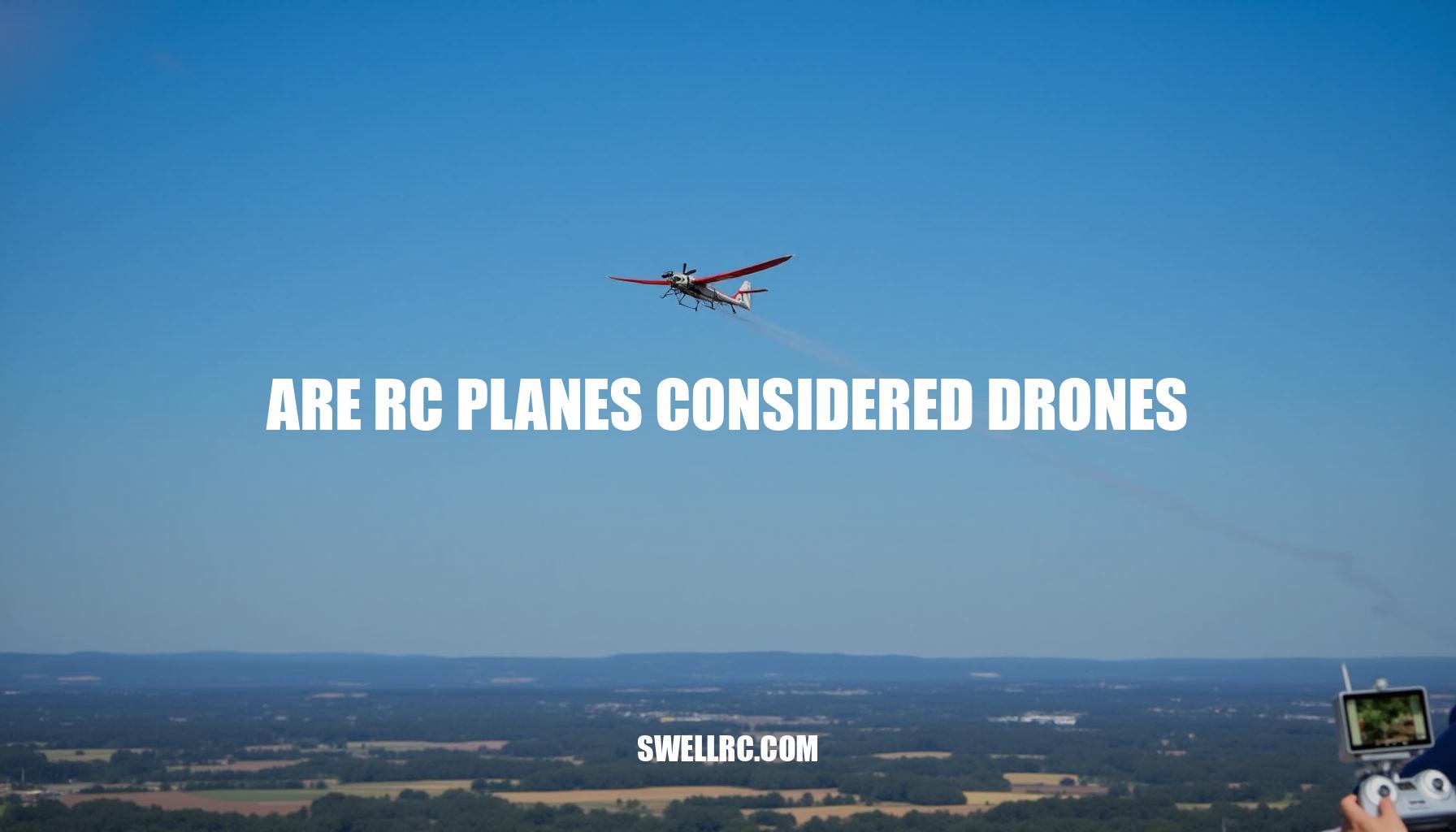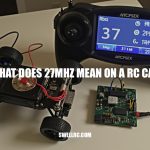Are RC Planes Considered Drones? A Comprehensive Guide
I still remember the afternoon I bolted a tiny GPS puck onto a foam warbird just to see if I could coax a return‑to‑home arc out of a “pure” RC plane. The moment it circled back on its own, my favorite hobby question got louder: are RC planes considered drones? In simple terms, an RC plane is a radio‑controlled model aircraft you actively fly, typically line‑of‑sight, with your sticks doing the real work.
A drone, or unmanned aerial vehicle (UAV), is any unmanned aircraft that can fly with onboard assistance—anything from auto‑level to full autopilot and waypoint missions—often with a camera onboard. Today, the line between model planes and drones blurs fast. Hybrid models like the KT RC Foam Aircraft Fighter Drone Jet show how drone‑grade stabilization and features like GPS stabilization are migrating into airplane airframes.
Whether you’re passionate about FPV RC planes or electric RC planes, understanding the difference between RC planes and drones is key. Are RC drones and planes the same? Not exactly—while both fall under radio-controlled aviation, drones typically offer advanced autonomous capabilities.
This guide breaks down control differences, real‑world use cases, and regulator views so you’ll know what you’re flying, what to buy next, and how to fly smart and legal.
Understanding the Definitions: RC Planes vs. Drones
When exploring the distinctions between an RC plane definition and a drone definition, it’s clear that practical use often shapes how these terms are applied, despite significant overlap. A concise comparison snapshot helps clarify these differences:
| Aspect | RC Plane | Drone (UAV) |
|---|---|---|
| Airframe | Primarily fixed-wing; examples include classic gliders and sport planes. | Often multirotors, but also fixed-wing UAVs; versatile configurations. |
| Control Style | Typically hand-flown using radio control line of sight; pilot manages every maneuver manually. | Rely on flight controllers for stabilization, altitude hold, GPS navigation, and various levels of autonomy, including fully automated missions. |
| Avionics | Simple setup: receiver plus servos for controlling surfaces. | Enhanced avionics such as IMUs, barometers, GPS/compass, and complex software logic (e.g., ArduPilot, iNav, Betaflight-FixedWing). |
| Purpose | Emphasis on pilot skill, aerobatics, and scale modeling. | Focus on aerial imaging, surveying, automation, and efficiency in FPV RC planes operations. |
| Camera | Usually optional; many traditional RC planes fly without cameras. | Often equipped with cameras, frequently stabilized for smooth aerial footage. |
| Regulation | Both considered unmanned aircraft; regulatory rules depend on usage (recreational vs commercial), equipment weight, Remote ID requirements, autonomy level, and FPV usage. | Same as RC planes; laws focus on operational context and technical aspects rather than the label. |
A prime illustration of the terminology blending is the MQ‑9 Reaper RC Plane (see MQ‑9 Reaper RC Plane). This fixed-wing model mimics a UAV’s design yet can function in both paradigms: outfitted with a flight controller and GPS, it operates like a drone; when flown receiver-only, it is a traditional RC plane. Furthermore, FPV RC planes increasingly adopt drone-like qualities by shifting pilot perspective to onboard cameras, blurring the lines between manual radio control line of sight and autonomous UAV flight.
Legal and Regulatory Gray Areas
In the U.S., the FAA classifies any device capable of flying without a person onboard as an unmanned aircraft, meaning both RC planes and drones fall under the same regulatory umbrella. However, how you operate your aircraft and the equipment it carries can vary based on FAA rules. When exploring FAA drone laws, several key points become clear:
- Registration: Recreational aircraft weighing 0.55 lb (250 g) or more must be registered.
Those under 0.55 lb typically do not require registration unless flown under Part 107. For all commercial operations or flights under Part 107, registration is mandatory regardless of weight, addressing common questions like “do RC planes require registration?“
- Remote ID: Most unmanned aircraft must comply with Remote ID requirements unless operated within a FRIA (FAA-Recognized Identification Area) or qualify for an exemption. Many homebuilt fixed-wing models can use broadcast modules if they lack integrated Remote ID capabilities.
- Operational Rules: Recreational flyers follow 49 U.S.C. 44809 with community-based safety guidelines.
In contrast, Part 107 operators must hold certification, obtain airspace authorization, and adhere to documented operating limits.
- Altitude and Line of Sight: The general rule is to fly under 400 feet AGL in uncontrolled airspace, maintain unaided visual line of sight with your aircraft, and avoid flying over people or moving vehicles without proper waivers or authority.
- FPV (First-Person View) Considerations: For recreational flying, FPV is allowed only if a visual observer maintains unaided visual line of sight with the unmanned aircraft.
Since rules can vary globally, it’s important to always consult your local aviation authority for specifics. For hobby-grade and regulation-friendly options, you might explore selections like Pilot RC planes to ensure compliance and enjoyment while flying.
Technology Crossover: When RC Planes Act Like Drones
Once you add drone-class avionics like advanced flight controllers equipped with IMU, gyros, and accelerometers to a fixed-wing aircraft, the behavior changes profoundly. From my own builds, enabling features such as auto-level, return-to-home (RTH), and stabilized launch modes makes the airplane feel unmistakably “drone-like.” This fusion of technology underscores how function ultimately defines classification in aerial vehicles.
Consider these illustrative examples:
- An RC bomber plane dropping bombs adds mission-style features, enhancing operational complexity.
- An RC airplane equipped with a camera edges into UAV territory when paired with FPV, GPS stabilization, and telemetry links.
- First-person video (FPV), loiter patterns, and waypoint missions are hallmark features of UAV flight control systems, even on traditional fixed-wings.
Here’s a quick feature crossover overview highlighting the UAV features now common in advanced RC planes:
| Feature | Description | Relation to UAV/Drone |
|---|---|---|
| Flight Controller | IMU, gyro, accelerometer for stable flight and control inputs | Core of autonomous flight and stabilization |
| GPS + Magnetometer | Enables return to home and waypoint navigation | Key for precise autonomous missions |
| Barometer | Altitude hold capabilities for steady flight | Maintains consistent flight levels |
| Auto-Launch/Auto-Land | Automated takeoff and landing procedures | Signature UAV operational convenience |
| Geofencing and Failsafes | Flight boundaries and safety protocols | Critical for flight safety and legal compliance |
| Telemetry/On-Screen Display (OSD) | Real-time flight data link to ground station | Enables informed pilot decisions and monitoring |
| FPV Systems (Analog or HD) | First Person View camera feeds for immersive control | Transforms RC planes into fully immersive UAV platforms |
When enough of these features stack up, your traditional RC plane equipped with a camera and autonomous flight capabilities becomes, functionally, a drone. This convergence illustrates why the lines between rc planes with cameras vs drones are increasingly blurred, driven by advances like GPS stabilization, telemetry, geofencing, and FPV systems. Ultimately, it’s the integration of these UAV features that define modern aerial vehicles.
Building and Converting: DIY Insights
If you’re exploring how to convert an RC plane into a drone, it’s crucial to think in modular terms and approach the flight controller setup as a cohesive system rather than a collection of one-off add-ons. From my numerous test flights, I recommend this DIY RC plane roadmap for achieving reliable, drone-capable UAV performance:
- Choose a compatible flight controller such as iNav-capable boards or ArduPilot/Pixhawk, which offer comprehensive fixed-wing features.
- Add a GPS module and compass, along with a barometer-equipped FC to enable Return-To-Home (RTH), loiter, and altitude hold functionalities.
- Integrate power monitoring systems and reliable BEC/ESC components that support telemetry for real-time health checks.
- Install an FPV setup comprising a camera and video transmitter (VTX), coupled with an On-Screen Display (OSD); if budget allows, consider HD links to enhance your view.
- Program multiple autonomous modes including manual, stabilized (angle/level), RTH, cruise, and loiter, and meticulously verify fail-safes for safety.
- Calibrate all sensors thoroughly—accelerometer, compass, radio endpoints, and airspeed sensors if used—to ensure stable flight.
- Pay close attention to weight distribution and center of gravity (CG); often the heavier nose electronics help balance. Also, test glide characteristics before powering on for the maiden flight.
This step-by-step process will help transform your plane seamlessly into a drone-equipped UAV with advanced autonomous modes, typical of modern FPV RC planes. For a detailed walkthrough and examples, check out how to make an RC plane out of a drone on SwellRC.
The Hobbyist Perspective: Why the Confusion Matters
Words shape how non-pilots, regulators, and even retailers perceive our aircraft, influencing everything from field access to insurance. Call everything a “drone,” and you risk spooking a park ranger who’s comfortable with model planes but wary of quadcopters. Conversely, using “RC plane” might cause some to overlook advanced features like full autopilot with geofencing.
This terminology plays a crucial role in the RC community, affecting not only perceptions but also buying decisions and cultural expectations among pilots.
- On the commercial side, collections such as Essential RC planes and World Models RC planes are popular among pilots who value scale models and increasing their stick and rudder skills.
- In contrast, individuals who commonly use the word “drone” often seek products focused on stabilization and aerial imaging.
- The RC planes vs drones debate highlights the varied expectations and functionalities within the hobby.
- Personally, I enjoy the versatility of fixed-wing aircraft—one weekend practicing manual belly-landings, the next engaging in long-range FPV flights with Return to Home (RTH) as a safety net—showcasing the exciting overlap within the FPV culture.
Ultimately, with greater capabilities come the responsibility to fly within established regulations and respect the culture supported by our flying fields.
Choosing the Right Model: Practical Buying Guidance
When buying RC planes, it’s crucial to pick by purpose, not by label. This ensures you select an airframe and features that truly match your mission. For example, if your goal is to capture stunning aerial photo/video, prioritize UAV features like stabilization, efficient cruise, and a clean camera mount.
Beginners learning to fly might prefer gentle fixed-wings equipped with gyro assist, made from durable foam for easy repair. Speed enthusiasts aiming for warbirds or jets should opt for stiffer airframes, higher wing loading, and strong power systems. Long-range FPV pilots benefit from efficient wings, large batteries, and reliable telemetry with return-to-home (RTH) capabilities, while STEM or DIY hobbyists need roomy fuselages with modular bays that simplify CG management.
Among the options, Motion RC offers a balanced performance and selection suitable for diverse needs, while Durafly is known for beginner-friendly and dependable aircraft. To aid your decision, consider the following feature comparison that highlights factors like flight time, ease of control, camera integration, repairability, and field requirements:
| Use-Case | Flight Time | Ease of Control | Camera Integration | Repairability | Field Requirements |
|---|---|---|---|---|---|
| Aerial Photo/Video | High (efficient cruise + battery capacity) | Gyro/Electronic Stabilization | Gimbal Mount or Action Cam Bay | Moderate (depends on foam type) | Runway Preferred |
| Learn to Fly | Moderate | Gyro Assist (Beginner RC Aircraft) | Basic Action Cam Mount | High (durable foam, readily available parts) | Hand-Launch, Small Landing Space |
| Speed/Warbirds/Jets | Lower (high wing loading, strong power) | Manual or Assisted | Limited or Specialized | Moderate (stiffer airframe repair) | Runway Needed |
| Long-Range FPV | Very High (large batteries) | Assisted with Telemetry & RTH | FPV Bay | Moderate | Hand-Launch or Runway |
| STEM/DIY | Variable | Manual | Modular Options | High (easy access, modular bays) | Flexible |
By focusing on these snapshot comparison factors and understanding your specific needs, you can confidently choose the best RC plane. Whether you prioritize flight time, ease of control, or camera integration, brands like Motion RC and Durafly provide excellent options. Always evaluate how “drone-like” you want your plane to be with avionics and select accordingly to enhance your experience in the world of buying RC planes.
Conclusion: Defining the Future of RC Flight
So, are RC planes considered drones? Summary: legally, both fall under unmanned aircraft, but the distinction blurs depending on avionics and operation. Classic RC planes operate with simple receiver‑servo setups, while adding flight controllers, GPS, and autonomous modes transforms them into fixed‑wing UAVs—essentially drones in spirit and function.
When comparing RC planes vs drones, functionality and regulatory treatment converge, especially regarding FAA rules.
The FAA rules generally treat RC planes and drones similarly, with nuances depending on factors like weight and use cases. Key considerations include:
- Remote ID: Mandatory broadcasting of identification and location is required for many UAV operations, affecting both drones and advanced RC planes.
- Autonomy: The level of automated flight control impacts classification and operational constraints.
- Operational Context: Recreational pilots face different regulations compared to those flying under Part 107 commercial certifications.
Looking toward the future of RC aviation, technology will continue to blur the lines between traditional RC planes and autonomous drones. Enthusiasts enjoy a spectrum—from pure stick‑and‑rudder piloting to sophisticated automation-assisted flight.
This evolution fosters exciting opportunities for innovation and exploration in fixed-wing unmanned flight. As these categories merge, pilots and hobbyists alike will benefit from increased flexibility and capability while navigating evolving regulatory landscapes.
Frequently Asked Questions
- What’s the main difference between RC planes and drones?
RC planes are typically hand‑flown fixed‑wings with minimal onboard assistance, while “drones” usually rely on flight controllers for stabilization, GPS features, and even full autonomy. The airframe can be the same; the distinction is mostly about avionics and how you operate the aircraft. - Are RC planes regulated like drones by the FAA?
Yes. Both are “unmanned aircraft.” Recreational flyers follow 49 U.S.C. 44809; aircraft ≥0.55 lb (250 g) require registration, and most craft need Remote ID unless flying in a FRIA or otherwise exempt. Commercial (Part 107) operations require certification and additional compliance. - Can an RC plane be modified to work as a drone?
Absolutely. Add a flight controller with IMU/baro, GPS/compass, power monitoring, and program modes like stabilize, return‑to‑home, and loiter. Integrate FPV and telemetry for full UAV‑style operation. - Which is easier to fly — an RC plane or a drone?
A stabilized multirotor drone is usually easier because it can hover and self‑level. Trainer RC planes with gyro assist are beginner‑friendly but still need more space, airspeed management, and coordinated control. - Do RC planes have cameras like drones?
Many do. Fixed‑wings often carry action cameras or FPV systems. They rarely use 3‑axis gimbals like camera drones, but you can achieve smooth footage with good mounting, higher airspeeds, and stabilization in post. - Are all radio-controlled aircraft technically drones?
In common speech, “drone” implies onboard automation. Legally, all radio‑controlled aircraft are unmanned aircraft, but not all are “drones” in the autonomous or semi‑autonomous sense unless they carry and use those avionics.



